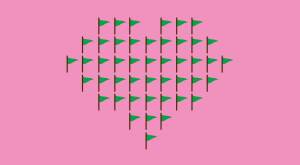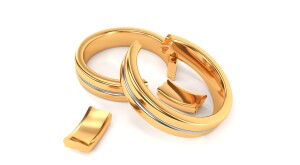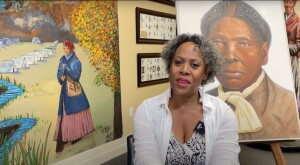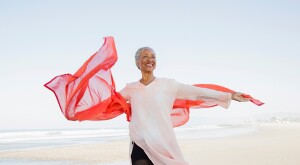From the editors: The Black community is coping with historic challenges relating to social justice, health and the economy. We’re all in this together. During this turbulent time, Sisters From AARP is prioritizing new and existing content that supports our readers’ mental, physical and economic safety and well-being, including this story. Feel free to email us at sistersletter@aarp.org and share your thoughts on how we, as Black women, can best support one another now.
I’m sitting in my living room, taking an online Meridian Touch yoga class. I am pressing a rather tender spot on my upper chest area, near my shoulder blade. The instructor, shiatsu therapist Darryl Aiken-Afam, founder of Meridian Touch LLC (@MeridanTouch), tells us that this acupoint (stimulus point for acupuncture) is called Lung 1. He believes it can be beneficial during the pandemic, as it assists with breathing, and can also help alleviate stress.
With the deep belly breathing along with, I assume, the meridian points that are being reached, I am becoming super calm and relaxed. In fact I fight the urge to curl up into a fetal position and nap during class (after all, he can’t see me). I think about what I’ve read about the health benefits of acupuncture, and how much I long for a therapeutic massage, neither of which is available while sheltering in place. Acupressure is a type of massage that reaches the same acupoints as acupuncture and is something that I can do at home, at no cost and —yea! — without penetrating my skin with needles.
Acupressure, an ancient form of massage used in traditional Chinese medicine (TCM), has been practiced for over 5,000 years. It is based on the tradition’s principle that there are lines of energy (qi) within the body called meridians. Sometimes these meridians become blocked causing health issues and disease. Acupressure stimulates specific points to clear these blockages.
Western medicine has done limited studies on acupressure’s effects on diseases. While current studies conclude that any physical benefits are due to what typically happens with massage, such as relaxation and improved blood flow, more research is needed. Currently, acupressure has been shown to help with headaches and pain, calm nerves and reduce anxiety.
“Doing self-acupressure or self-shiatsu can be helpful in that it has a similar relaxing effect as getting a real massage,” confirms Aiken-Afam. “The biggest part of the healing process, in regard to touch, is activating the parasympathetic nervous system, because that’s the healing, recovery and relaxation part of the nervous system, while the sympathetic is the fight or flight.”
Today, many traditional healing techniques are used along with conventional therapies as complementary medicine. Specialists in integrative medicine take this wholistic approach. Always see your physician regarding a new symptom or preexisting condition. If you want to ease your body’s distress signals, Aiken-Afam has four acupressure point treatments you can do at home. (The benefits noted are based on traditional knowledge.)
Before you begin
If pressing a point hurts too much, don’t do it. If you are wincing, tightening up your body or experiencing shallow breathing when pressing a point, it is counterproductive, advises Aiken-Afam.
There are no contraindications for these acupoints, but if you are pregnant or have a medical condition (high blood pressure, cancer, etc.) discuss using acupressure with your health care professional.
Tips
• For each point, press for 30 seconds while breathing into the belly. As you breathe through your nose the air should flow into your abdomen, causing it to expand. Exhale slowly through slightly pursed lips, as your belly slowly deflates.
• Do 2 to 3 repetitions, pressing the points.
• Repeat this 3 to 4 times a week.
1. Conception vessel 6 (CV 6)
This point strengthens overall body health and well-being, according to practitioners of this healing art. “It strengthens the immune system, improves digestion,” says Aiken-Afam, “and creates better flow of chi [energy] and blood between the upper and lower body.”
How to do it: Measure down an inch and a half below your navel. Press in with the pads of the fingers, moving the fingers around to find the most tender part of that area.
2. Gall bladder 20 (GB 20)
Feeling tense? Tension can cause headache (including migraines), a stiff neck and shoulder pain. This point can help with that, along with relaxing the scalp and lowering blood pressure.
How to do it: Find two big muscles in the neck on either side of the center of your spine. Gently grasping your head with your hands at either side, take your thumb and press on the outside of those two big muscles, pressing up into the skull, with your head leaning back slightly. You should find two indentations — one on each side — where the GB 20 is lateral to the two big muscles in the neck.
3. Heart constrictor 8 (HC 8)
Also referred to as Pericardium 8, this point “helps in lowering blood pressure, soothing emotional irritation and anxiety and lifting the spirit out of sadness. It also clears the mind, supporting the capacity for clear thought,” says Aiken-Afam.
How to do it: With your palm facing you, make a fist. This point is located where your middle finger touches your palm. Take your thumb on the other hand and press around in that area. Press until you can find the most sensitive or active point in that area where your middle finger touched your palm.
4. Lung 1 (LU 1)
This acupressure point helps activate respiratory function to help you breathe better. “If a person is having an asthma attack, is stuffy or sick, has bronchitis or things of that nature, it will help to aid with a person’s breathing,” says Aiken-Afam. (But consider this as an adjunct to conventional therapy. If you use any respiratory medicine such as a rescue inhaler or allergy drug, be sure to take it as directed.) “It provides relief, expansion and strengthening of the lungs and respiratory system. It also helps with lifting the mind out of sorrow and depression due to grief or loss, and helps the body feel less heavy and more light while strengthening the immune system.”
How to do it: Take the pads of the fingers and press and massage the upper corner of the pec muscle where it starts to create a hollow or dip right before it goes to the shoulder. Press in that area at the top corner of that pec until you find something tender or a little sore point. This is the Lung 1 point.
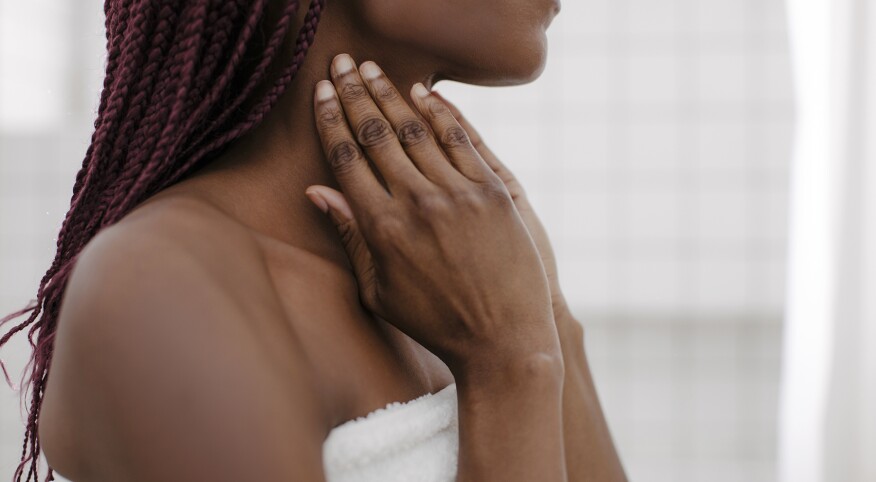
Getty Images





